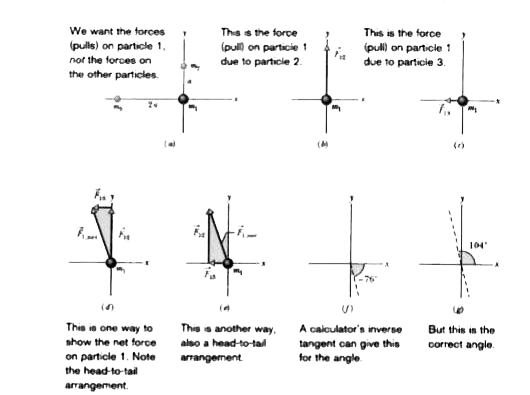A particle of mass is kept on the surface of a uniform sphere of mass and radius . Find the work to be done against the gravitational force between them to take the particle away from the sphere.
(1) Because we have particles, the magnitude of the gravitational force on particel 1 due to either of the other particle is given by Eq. 13-1 . (2) The direaction of either gravitational force on particle 1 is toward the particle responsible for it. (3) Because the forces are not along a single axis, we connot simply add or subtract their magnitudes or their components to get the net force. Instead,we must add them as vectors.
Calculations : From Eq. 13-1, the magnitude of the force on particle 1 from particle 2 is
. (13-7)
Similartly, the magnitude of force on particle 1 form particel 3 is
. (13-8)
Force is directed in the positive direactionof the y axis (fig. 13-4b) and has only the y component . Similarly, is direacted in the negative direaction of the x axis and has only the x component : We draw the force diagrams with the tail of a force vector anchored on the particel experiencing the force. Drawing them in other ways invites errors, especially on exams.)
To find the net force on particle 1, we must add the two forces as vectors (figs 13-4d and e). We can do so no a vector-calculator. However, here we notes as vector -capable calculator. However, here we note that are actually the x and y components of . Therefore, we can use Eq. 3-6 to find first the magnitude and then the direaction of . The magnitude is
.

Figure 13-4 (a) An arrangement of three particle. The force on particle 1 due to (b) particel 2 and ( c) particle 3.(d)-(g) Ways to combine the forces to get the net force magnitude and orientation. In Wiley PLUS, this figure is avaliable as an animation with voiceover.
Relative to the positive direction of the x axis, Eq. 3-6 gives the direactionof as
.
Is this a reasonable direaction (Fig.13-4F) ? No, because the direaction of must be between the dreaction of . Recall from Chapter 2 that a calculator displays only one of the two possible answers to a funeton . We find the other answer by adding :
.
which is a reasonable direaction for (Fig.13-4g).
Topper's Solved these Questions
- BOOK - RESNICK AND HALLIDAYCHAPTER - GRAVITATIONEXERCISE - CHECKPOINT5videos
GRAVITATION
- BOOK - RESNICK AND HALLIDAYCHAPTER - GRAVITATIONEXERCISE - PROBLEMS63videos
GRAVITATION
- BOOK - RESNICK AND HALLIDAYCHAPTER - GEOMETRICAL OPTICS : REFRACTIONEXERCISE - Practice questions(Integers)4videos
GEOMETRICAL OPTICS : REFRACTION
- BOOK - RESNICK AND HALLIDAYCHAPTER - HEAT-MEASUREMENT AND TRANSFEREXERCISE - PRACTICE QUESTIONS( INTEGER TYPE)5videos
HEAT-MEASUREMENT AND TRANSFER
Similar Questions
kAS particle of mass 100 g is kept on the surface of a uniform sphere of mass 10 kg and radius 10 cm. Find the work to bbe dne against the gravitational force between them to take the particle away from the sphere.
View SolutionA particle of mass 1 kg is kept on the surface of a uniform thin spherical shell of mass 20 kg and radius 1 m. Find the work to be done against the gravitational force between them to take the particle away from the thin spherical shell.
View Solution
Knowledge Check
- Question 1 - Select One
A particle of mass 10g is kept on the surface of a uniform sphere of mass 100 kg and radius 10 cm. Find the work to be done against the gravitational force between them, to take the particle far away from the sphere (you may take G=6.67×10−11Nm2/kg2)
A13.34×10−10JB3.33×10−10JC6.67×10−9JD6.67×10−10J - Question 2 - Select One
A particle of mass 10g is kept on the surface of a uniform sphere of masss 100kg and radius 10cm. Find the work to be done against the gravitational force between them to take the particel far away from the sphere (you may take G=6.67×10−11Nm2kg2)
A3.33×10−10JB13.34×10−10JC6.67×10−10JD6.67×10−9J - Question 3 - Select One
A particle is kept on the surface of a uniform sphere of mass 100 kg and radius 10 cm. Find the work to be done per unit mass against the gravitational force between them, to take the particle far away from the sphere (you may take h=6.67×10−11Nm2kg−2)
A13.34×10−10JB3.33×10−10JC6.67×10−9JD6.67×10−8J
A particle of mass m is kept on the axis of a fixed circular ring of mass M and radius R at a distance x from the centre of the ring. Find the maximum gravitational force between the ring and the particle.
View SolutionA particle of mass m was transferred from the centre of the base of a uniform hemisphere of mass M and radius R into infinity.
What work was performed in the process by the gravitational force exerted on the particle by the hemisphere?View SolutionTwo spheres, each of mass 625 kg, are placed with their centres 50 cm apart. The gravitational force between them is
View SolutionTwo particles of masses 1 kg and 2 kg are placed at a separation of 50 cm find out gravitational force between them
View SolutionA uiform ring of mass M and radius R is placed directly above a uniform sphere of mass 8M and same radius R. The centre of the sphere. The gravitational atraction between the sphere and the ring is
View Solution

